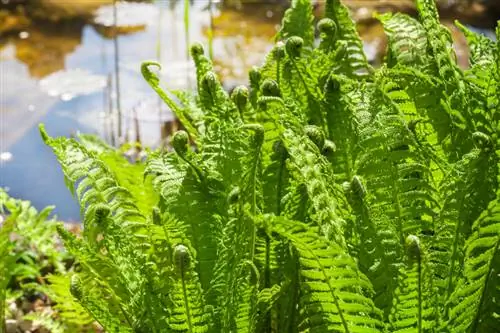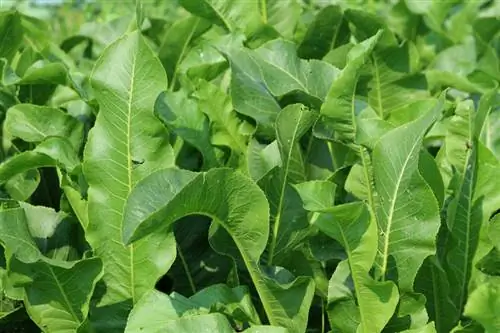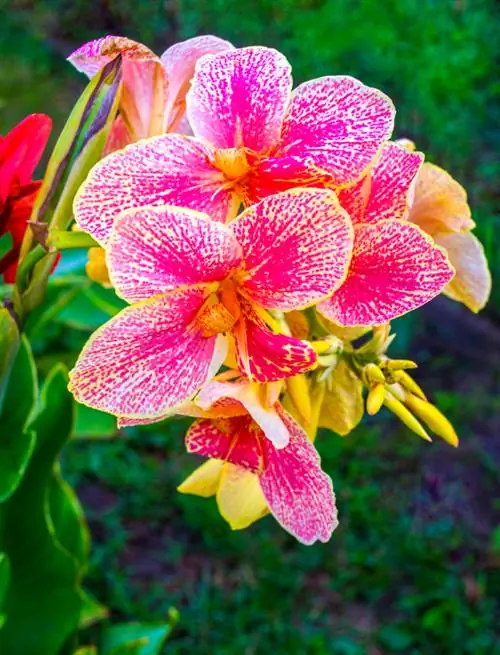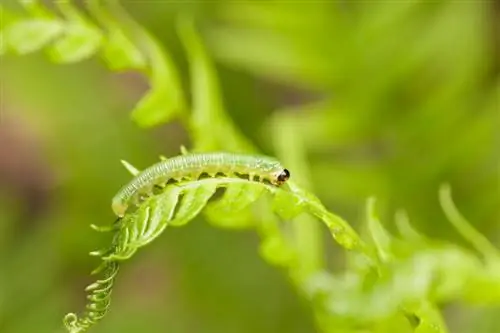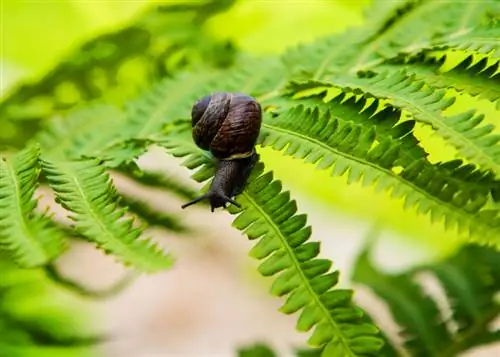- Author admin [email protected].
- Public 2023-12-16 16:46.
- Last modified 2025-01-23 11:22.
Thanks to worm fern, dim garden niches and corners of rooms do not remain idle, but are filled with lush green decorative fronds. The following lines reveal why the robust worm ferns are one of the most popular design elements in the garden and home.
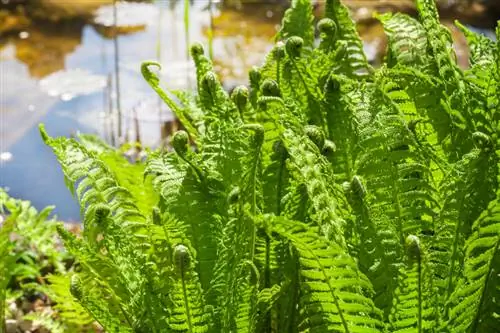
How do you successfully cultivate a worm fern?
Worm fern is a hardy, lush green plant that is ideal for partial to shady locations in gardens and indoors. Thorough soil preparation, adequate water supply, regular fertilization and care are important for successful cultivation. Propagation occurs through division or spore sowing.
Planting worm fern correctly
Well-thought-out planting controls the growth and vitality of worm ferns right from the start and ensures problem-free cultivation. Pay attention to these steps:
- Soak the root ball in soft water until no more air bubbles appear
- Meanwhile, rake and weed the soil thoroughly in the partially shaded to shady location
- Dig planting pits with twice the volume of the root ball
- Optimize the excavation with compost, peat, ericaceous soil and horn shavings
Maintain the previous planting depth of a young plant as precisely as possible and then water generously. A mulch layer of leaves, needle compost or lawn clippings proves to be beneficial for establishing the roots.
Care tips
Water plays a central role in the maintenance work. All other measures follow this. How to do it right:
- If the soil dries, worm ferns are watered
- Use predominantly soft water
- Shower or spray the green fern fronds with water every 1-2 days
- From March to September, fertilize monthly organically or with special fern fertilizer (€89.00 on Amazon) without s alt and lime
- When wintering warm behind glass, water less and fertilize every 6-8 weeks
Cut out withered leaves regularly and sprout new fronds. Pruning close to the ground is only carried out late in winter, when the underground rhizome has drawn in all parts of the plant.
Which location is suitable?
A semi-shady to shady location promotes the vitality and he alth of this lush foliage plant. It is best to plant worm ferns in wind-protected locations to avoid a disheveled appearance.
The correct planting distance
The selected species and variety defines the specific planting distance. For the majestic common worm fern, a distance of 70-100 centimeters is considered appropriate, while the delicate Krauser worm fern can cope with a distance of 50 centimeters from its neighbor.
What soil does the plant need?
If the soil is equal to good forest soil, you will enjoy your worm fern for a long time. Nutrient-rich, humus-rich, low in lime and, above all, fresh and moist should be the dominant attributes. For planters, we recommend a mix of rhododendron soil, compost and peat with a handful of clay for best water storage ability.
What is the best time to plant?
The best time to plant worm ferns is from March to May. During the dry summer months, planting should only be considered in exceptional cases, provided that a daily water supply is guaranteed initially.
Cutting the worm fern correctly
If you regularly cut out wilted leaves, this will encourage new growth of young fronds. Since worm ferns wear their green dress well into the winter, only cut off the retracted parts of the plant close to the ground in late winter.
Watering worm fern
Water plays a key role in caring for worm ferns. Water regularly as soon as the substrate dries. However, avoid the formation of waterlogging. Since worm ferns are sensitive to lime, we recommend using collected rainwater. A shower with soft water also helps maintain vitality.
Fertilize worm fern properly
As classic humus roots, worm ferns don't like s alt or lime. To supply nutrients, use compost, plant manure or special fern fertilizer from specialist retailers. How to properly fertilize the green plant:
- Fertilize the bed organically every 4 weeks from March/April to September
- Provide potted plants with liquid fertilizer or granules, sticks or cones
Warm ferns cultivated indoors all year round at room temperatures should be fertilized every 6-8 weeks in winter, as the plants do not take a break from growth in this case.
Diseases
Worm ferns are spared from diseases if they are cared for properly. On the contrary, the leaves, fermented into manure, serve as a biological control agent against powdery mildew, gray mold and late blight.
Pests
Worm ferns are at the top of the menu for voracious weevils. If there are traces of feeding on the leaves in the form of holes or bulges, act as follows:
- Lay out bait traps for adult beetles, prepared with nematode gel (available from specialist retailers)
- Fight the larvae with nematode powder, dissolved in water and applied with a watering can
Wintering
Worm ferns are completely hardy and keep their pretty leaves until late winter. Special precautions are only recommended for potted plants. How to handle it correctly:
- Before the first frost, cover the bucket with bubble wrap
- Place the vessel on wood in front of the protective south wall of the house
- You can choose to overwinter in a partially shaded, frost-free window seat
- Reduce watering and fertilize every 6-8 weeks
Propagate worm fern
To grow more worm ferns, the following propagation methods are available:
- Division of rhizomes in spring: the method suitable for beginners
- Sowing ripe spores in July/August: suitable for advanced users, complex and lengthy
worm fern in pot
Particularly delicate hybrids, such as Crispa Cristata, are recommended for cultivation in pots. This is how planting and care proceed in a regulated manner:
- Create a drainage over the water drain from expanded clay or pottery shards
- Fill half of nutrient-rich substrate with acidic pH value
- Insert the potted young plant soaked in water in the middle
Water worm ferns in pots regularly with soft water and spray the fronds every 1-2 days. From March to September, apply diluted special fertilizer every 4 days. From October to February, extend the time intervals to 6-8 weeks.
Is worm fern poisonous?
All ferns on earth pose a toxic threat. Worm ferns, however, have a rather low proportion of toxins. However, small children and pets should not get to the leaves. We recommend that sensitive gardeners use gloves when planting and caring for plants.
How do I transplant correctly?
Do not allow worm ferns to change locations when they are young. Only when they are older do the green plants survive being transplanted without damage. Choose a date in early spring, after pruning and before fresh growth. The soil in the new place should be optimized with compost and peat and the transplanted plant should then be watered abundantly.
The most beautiful varieties
- Barnesii: a magnificent specimen from the worm fern family that scores with a tight, upright habit
- Crispa Cristata: the compact variety impresses with curled fronds that look great in the pot
- Goldscale fern: a noble variety with yellow-gold iridescent, wintergreen leaves for sunny locations
- Red veil fern: sets decorative accents in beds and pots with red shoots in spring

